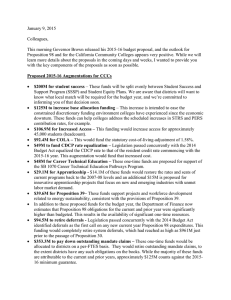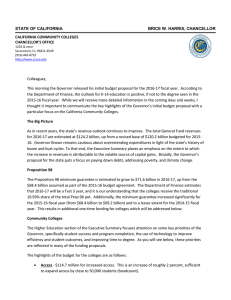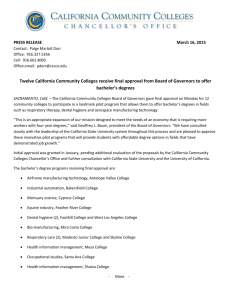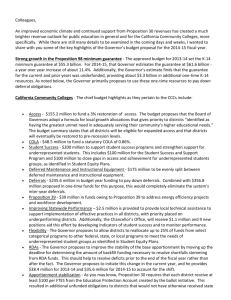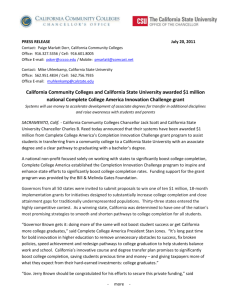MRBudgetUpdate.BOG.15
advertisement
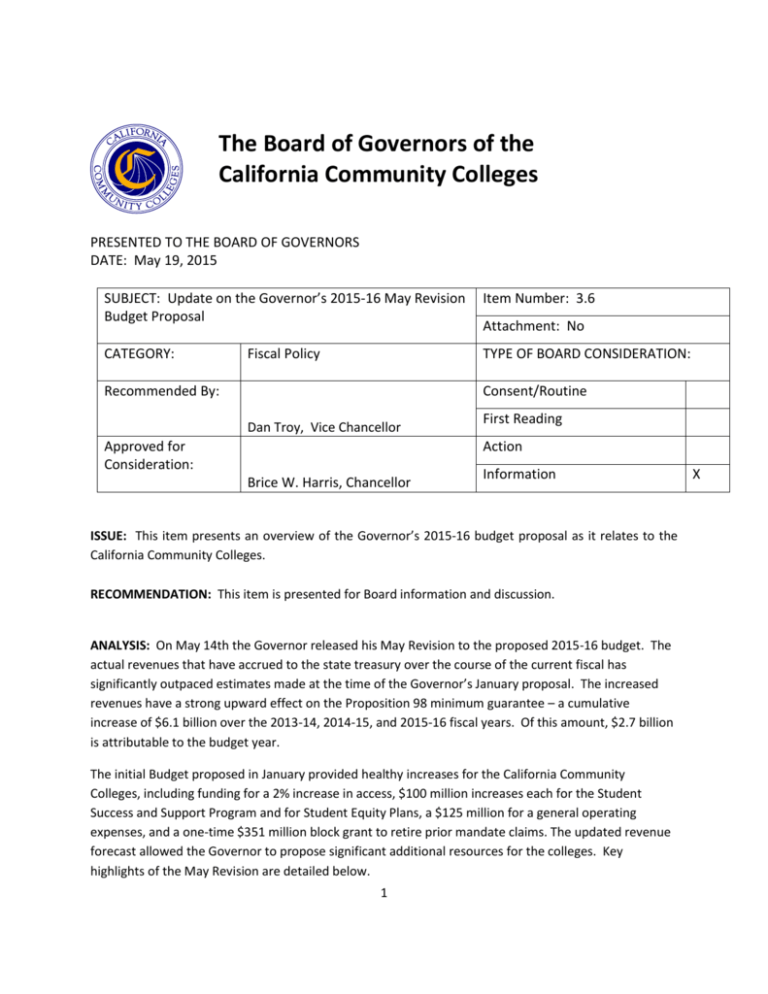
The Board of Governors of the California Community Colleges PRESENTED TO THE BOARD OF GOVERNORS DATE: May 19, 2015 SUBJECT: Update on the Governor’s 2015-16 May Revision Budget Proposal Item Number: 3.6 CATEGORY: TYPE OF BOARD CONSIDERATION: Fiscal Policy Recommended By: Attachment: No Consent/Routine Dan Troy, Vice Chancellor Approved for Consideration: First Reading Action Brice W. Harris, Chancellor Information ISSUE: This item presents an overview of the Governor’s 2015-16 budget proposal as it relates to the California Community Colleges. RECOMMENDATION: This item is presented for Board information and discussion. ANALYSIS: On May 14th the Governor released his May Revision to the proposed 2015-16 budget. The actual revenues that have accrued to the state treasury over the course of the current fiscal has significantly outpaced estimates made at the time of the Governor’s January proposal. The increased revenues have a strong upward effect on the Proposition 98 minimum guarantee – a cumulative increase of $6.1 billion over the 2013-14, 2014-15, and 2015-16 fiscal years. Of this amount, $2.7 billion is attributable to the budget year. The initial Budget proposed in January provided healthy increases for the California Community Colleges, including funding for a 2% increase in access, $100 million increases each for the Student Success and Support Program and for Student Equity Plans, a $125 million for a general operating expenses, and a one-time $351 million block grant to retire prior mandate claims. The updated revenue forecast allowed the Governor to propose significant additional resources for the colleges. Key highlights of the May Revision are detailed below. 1 X Additional Resources Proposed in the May Revision $75 million to support an increase in full-time faculty hiring. Funding would be allocated per FTES, but districts with relatively low proportions of full-time faculty would be required to hire more than districts with relatively high proportions of full-time faculty. $141.7 million in additional funds for support of district general operating expenses, bringing the proposed total to $266.7 million for the 2015-16 fiscal year. These funds will partially restore purchasing power lost during the economic downturn due to foregone COLAs and help districts to address the large increases in STRS and PERS employer contributions that are scheduled over the next few years. $274.7 million in additional funds to pay down prior mandate obligations, bringing the proposed total to $626 million ($501 million in one-time funds). These funds would distributed on a perFTES basis. $148 million for deferred maintenance and instructional equipment. Of this amount, $48 million is attributable to the current fiscal year. No local match is required. $60 million in one-time funds for the Basic Skills and Student Outcomes Transformation Program. These funds are intended to improve basic skills instruction through adoption and/or expansion of evidence-based models of placement, remediation, and student support that will aid the progress and success of basic skills students. $15 million increase for Student Equity Plan funding, bringing the total proposed increase to $115 million for the 2015-16 fiscal year. Concurrently, provisional language will require the implementation of SB 1023 (Liu, 2014), which authorizes a pilot program to provide additional support for foster youth who participate in EOPS. $15 million increase for the Institutional Effectiveness Partnership Initiative. Of this amount, $3 million will go toward technical assistance and the remaining $12 million is for the development and dissemination of effective practices. Provisional language would prioritize development of curriculum and practices for members of the California Conservation Corps and for inmates pursuant to SB 1391 (Hancock, 2014). $2.5 million to fund the COLA for the EOPS, DSPS, CalWORKs, and the Childcare Tax Bailout programs. $2 million in one-time funds for a pilot program to foster collaboration between community colleges and CSU campuses relating to basic skills instruction for incoming CSU students. A decrease of $825,000 in energy efficiency funding pursuant to the California Clean Energy Jobs Act (Proposition 39, 2012). This reduces the amount available in 2015-16 to $38.7 million. $25 million increase in Proposition 98 funds for the Awards in Innovation in Higher Education. This would bring the proposed total funding to $50 million for the 2015-16 fiscal year (half Prop 98, half non-98). The May Revision would also reclassify $23 million in current year awards as Proposition 98 funds, reflecting awards coordinated by community colleges. The May Revision further proposes to allow community colleges may be lead applicants for awards. The May Revision makes various other adjustments to the general apportionment, such as the inclusion of funding for projected FTES restoration and revised estimates concerning property taxes and fee revenues. The May Revision also proposes 6 new positions for the Chancellor’s Office. 2 Changes to Access Funding and COLA $49.7 million to increase access from 2 percent to 3 percent ($156.5M total for 2015-16). A decrease of $31.3 million to reflect a downward adjustment in the COLA from 1.58% to 1.02%. Inmate Education and the Veterans Nonresident Tuition Language included in the budget bill would declare the intent that the Chancellor identify districts willing to utilize a total of $5 million of funding for the purpose of providing adult inmate education. The language further notes that these districts would then be eligible to receive a 1 to 3 match of private donations dedicated for this purpose. Trailer legislation associated with the budget would conform state law to the Federal Veterans Access, Choice and Accountability Act (VACA) of 2014. VACA requires the US Dept. of Veterans Affairs to disapprove programs of education eligible for GI Bill benefit programs if those institutions charge qualifying veterans and dependents tuition in excess of the in-state rate after July 15, 2015. This language would alter state law such that qualifying veterans would not be subject to nonresident fees even if they do not meet resident status. It further clarifies that districts could claim apportionment for these students, thus holding them harmless from costs of instruction. Adult Education The Governor proposes significant changes to the Adult Education reform proposal introduced in January, including the following: Remove the specified local consortium allocation boards, which had included non-education representatives. Instead the Governor’s revised proposal would require the Chancellor and the Superintendent to approve rules and procedures for transparent and inclusive governance at each consortium. Requires adoption of comprehensive local plans every three years, rather than annually. Specifies deadlines to various activities by which the Chancellor and the Superintendent must adhere, including a certification of K12 district expenditures for relevant adult education in prior years; a deadline by which to apportion funds to K12 entities equal to the certified amounts; allocation and later apportionment of funds representing the remainder of the noncertified funds; schedules for determining allocations in future years; and other requirements. Removes the requirement for a consortium to have a fiscal agent and allows members agencies to receive funds directly based on a schedule submitted by the consortium. Requires the Chancellor and the Superintendent, in any schedule of allocations, projections of the amounts that would be apportioned in the subsequent two years. 3 Specifies that the amount of funds distributed to a consortium may not be reduced in future years except under specified circumstances. Requires community college districts to be members of consortia to be eligible to receive community college apportionments for courses in adult education and federal adult education programs (similar conditions would apply to K12 entities for K12 funding for adults). Requires the Chancellor and the Superintendent to submit plan by January 2016 to distribute federal adult education funds to the consortia. CONCLUSION: The Governor’s proposal to increase funding for the California Community Colleges at the May Revision is excellent news. These resources will aid us as we continue to recover from the devastating reductions of the economic downturn. Those funding reductions forced colleges to cut course sections, turn away hundreds of thousands of students, reduce crucial student support services, and tighten operational budgets, all the while dealing with new proposals to extend our reach, through the development of transfer degrees, the offering baccalaureate degrees, to increase distance education courses, etc. Even with this good May Revision news, it is important to remember that the colleges have not yet fully recovered from the economic downturn. We have not yet been funded to completely restore student access, and college operational budgets are still approximately $750 million behind where we were before the recession, accounting for inflation. Further, college budgets will face additional stresses in the coming years, as PERS and STRS obligations are scheduled to increase rapidly and the state faces the sunset of Proposition 30 revenues. Given these circumstances and our knowledge of the volatility of the state’s revenue system, we suggest that districts plan carefully now so they are prepared to meet the challenges ahead. Next steps in the budget process include review by the budget committees of each house, and a legislative conference committee to iron out differences between the two houses. It is expected that the budget will be approved and signed by the Governor prior to July 1, 2015. 4
